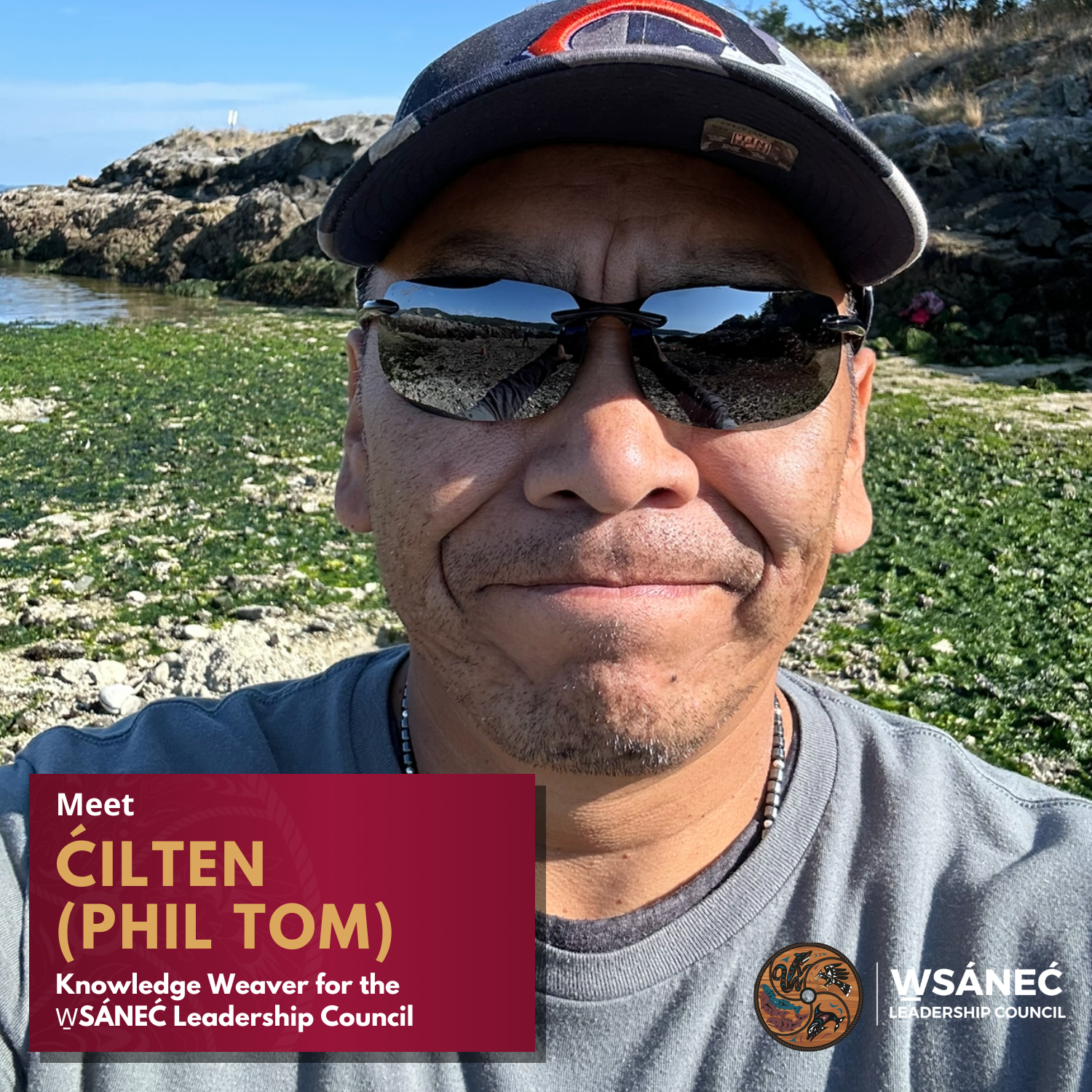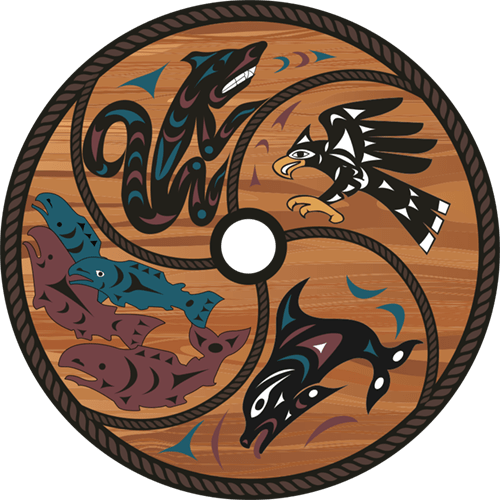Read the transcript below to learn more about ĆILTEN (Phil) and the impactful work he’ll be doing with the W̱SÁNEĆ Leadership Council.

Can you tell me a bit about who you are and where you’re from?
ÍY¸ ȻEĆIL, SI¸ÁM¸ ĆILTEN TŦE NE SNÁ ĆSELÁ¸E SEN W̱JOȽEȽP.
Good morning. I am from the Tsartlip First Nation and have grown up in our community all my life. I have four children and one grandson — three daughters and one son — and I have been part of the Tom and Bartleman family here in Tsartlip.
What kind of work will you be doing with the W̱SÁNEĆ Leadership Council?
The W̱SÁNEĆ Knowledge Weaver joined on as part of the revitalization of the clam gardens in the Gulf Islands. There are some historical clam gardens that have been worked on over the last 10 to 15 years by some of our members who have been part of this working group. We’re taking care of this clam garden wall on Salt Spring Island and Fulford Harbor. We’ve been putting in a lot of work over there, and that takes care of the sea life in the wall. We’ve also been revitalizing the beach for the clam life — turning sediment on the beaches and revitalizing the beach to see success and have clams return. That’s just one of the locations we’ve been working at, but it’s part of the project. Working with Parks Canada is part of the learning process — taking the lead from them and weaving that into where we take over the program as the W̱SÁNEĆ community.
Can you share some of the background and experience you bring to this position?
I grew up here in the community, living through my parents and grandparents’ ways of life and how they lived off the clams and shellfish and the beach. That was the experience. That was the curiosity to come back home and engage and work with my community, to make that connection back to my community. I want to come in with an open heart and mind just to learn more about it.
It’s not so much the experience I have that I bring to it; it is about the passion I’m bringing to it. To bring it forward, to learn more about it, what things have been done with this program, and also what things can be done to make it evolve into something more. This program has so much more potential than where it’s at right now.
Can you elaborate on the potential you see for this program?
I really want to see the management and the stewardship management come to take ownership back to our communities and our families. To manage these beaches the way it was pre-contact, and how it was where our elders, our ancestors, were tilling the beach and managing the beach.
I mentioned Fulford Harbour — the age on that wall is science carbon-dated back to 4000 years. So they’ve done some scientific digging on that to figure out the timeline of how that was made.
I think the full program would be to see it in, I guess, in full perspective is to really put it into a kind of food – but also a potential for commercial – a program where it would be self-sustaining, where we’re not relying on the government for funding just to keep this kind of program going. And if it’s commercially driven, where some of the work that the guys are doing on the beach is also turned into commercial, we can actually keep these guys working but also bring more people onto the beach to do more work.
And because our people don’t eat clams here in the community anymore. We have elders who have needs in the community, so I see many different things with the shellfish industry as a big potential.
What kind of impact do you hope to have during your time with the WLC?
The time and the amount of effort that’s being put into this program to date and to carry that responsibility forward. A worker before me was in this position and set a good standard. Following those footsteps that’s something to acknowledge.
I want to see this program evolve into something more, providing clams to the community members who really wish for those clams every time we go out and harvest. Spreading that around to each of our community members so it’s not just the W̱SÁNEĆ Leadership Council, which does encompass Tsawout, Tseycum, Pauquachin, and Tsartlip. Spreading around the distribution of the harvest when we do get it and bringing it out to different community members in our local area.
But to see this a bit more on the regular, where we’re not looking for annual funding to keep this going, we’re looking for something that would be an ongoing process and self-sustaining. It’s kind of on a whim right now of hoping, “Oh, maybe it will be funded again next year or a couple of years from now!” But I know there are many good people in the background doing some work, but you always hope for that kind of thing. If you can eliminate that hope and put your own control on it… The big dream is to have a partnership with Fisheries and work with us to develop a commercial industry with this shellfish industry. That’s the biggest part of the dream of potential, of what this could be — self-sustaining.
I think what I’m learning has to be shared with our people back here, at home, in our communities, and with our youth and our young children coming up. I think it’s really important to relay that we do have a structure that is around from 4000 years ago, from our ancestors — who actually built this clam garden wall — and how they came about it.
In the speculation from some of the elders of how the society was back then, you think about how the men were out gathering, hunting, and fishing — out in the water and away from the village. The women there also prepared food or did some things at home. So, you wonder…it had to have been some of the adolescent kids, some of the younger children, some of the elders that were down on the beach saying. ‘Okay, you guys pack those over on the wall.’ It wasn’t just the adults of the community that were down there.
I always hear, “Our communities weren’t lazy back then. We all worked together, and nobody was allowed to go and spend ten hours on their Xbox while the rest of the people were down on the beach doing the work. Everybody had to get down there and help.” That is the common message I’m hearing from different elders who have been on the beach and also part of our working group — with Carl Olsen, Tom Smith, Robert Sampson and Mark Sampson. They’ve all shared that same common view of looking at that society – “Let’s not think in our present time. Let’s think before about how things were managed.” That was the thoughts of some of our guys as well.
What do you like to do when you’re not at work?
When I’m not at work, I love to spend time with my grandson, my son, and my daughters. I love my family very much. Spending time with them is gold. I also enjoy hiking; I just need to be outdoors. And with this job, working outdoors is very refreshing. It’s a good blessing to be outdoors and get fresh air.
Just being with my kids is really the common answer that I can give. It’s where I make sure that I’m keeping myself grounded and humbled for my kids so that I don’t do anything out of the ordinary that embarrasses them.
Is there anything else you’d like community members to know?
I didn’t think working on the clam gardens was a way of reconnecting with history, or reconnecting with our culture, or reconnecting with our ancestors. But in some ways, I believe that visiting these sites is a way of doing that. To really honour yourself, honour your family and honour where you come from as a W̱SÁNEĆ member. Visiting these historical sites is very spiritual but also very appreciative. You have that longing of “Your ancestors were very smart people.” They were very intelligent in how to manage a beach and how to manage currents when they were out in the water.
The WSANEC people are referred to as the Saltwater People. I think it’s keeping ourselves connected to our history, keeping ourselves connected to the present time, and also taking care of our history in the present time so we have something to look forward to 9000 years from now. That’s what I would like to say. HÍSḴW̱E






